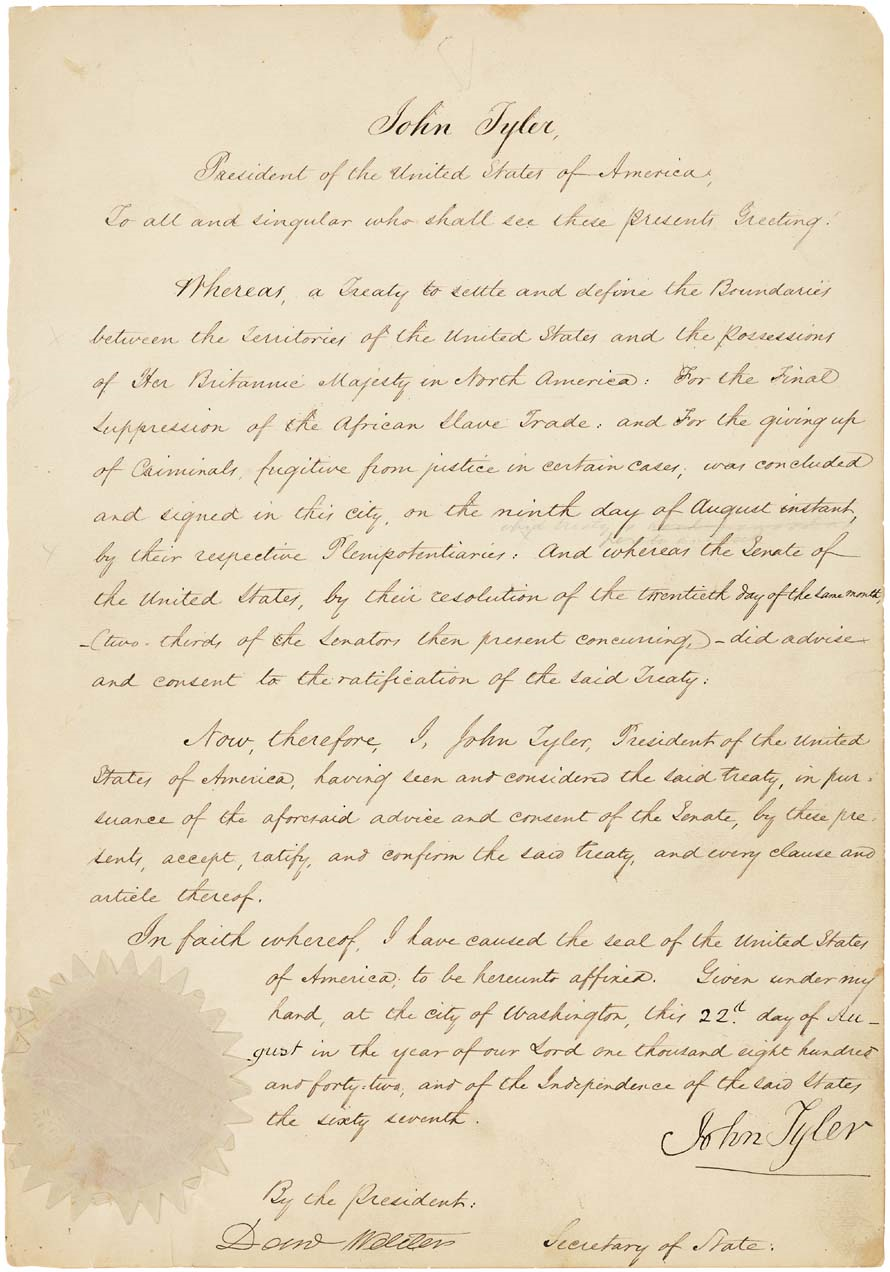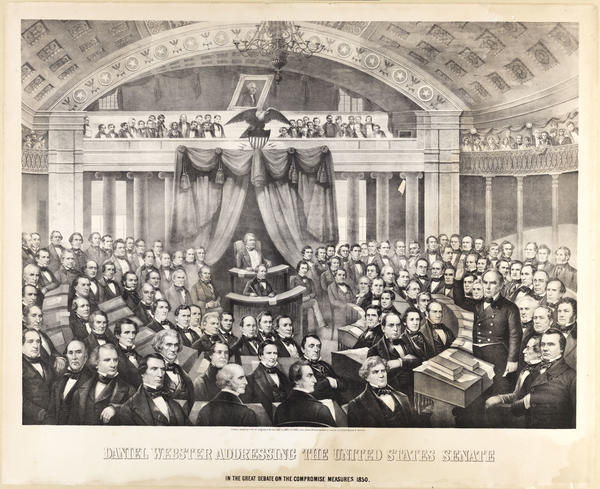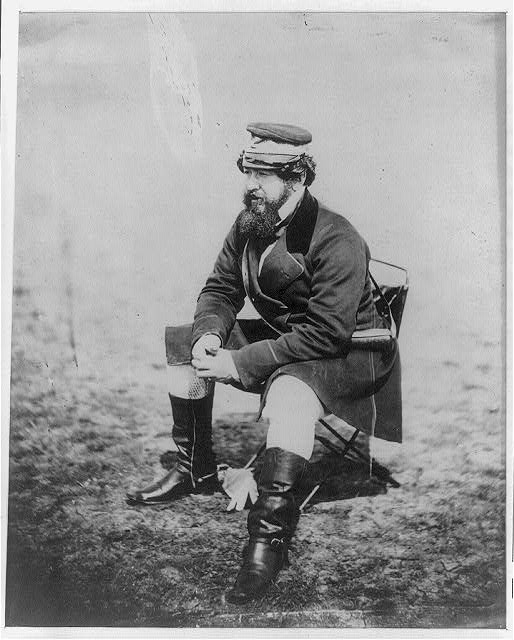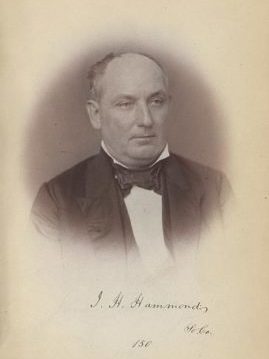Stemming from their shared history in the Colonial Period, and from decades of interaction through trade, the United States and United Kingdom retained diplomatic relations. While the memory of the American Revolution and War of 1812 was not lost, disagreement between the U.S. and British Empire throughout the mid-19th century was addressed peacefully. In situations where public tension called for retaliation or aggression, cooler heads prevailed through negotiation.
War in Europe and the declining political situation between the states occupied the attentions of the British and Americans respectively throughout the 1850s. By the point of the Secession Crisis of 1860, both powers had experienced political unrest and turmoil, each witnessing the troubles of the other. These events influenced attitudes held by both going into the Civil War, particularly concerning their views of one another.

Webster-Ashburton Treaty Signed
Settling the border disputes contributing to the non-violent Aroostook War over the boundary between the state of Maine and British New Brunswick, this agreement resulted in several additional terms regarding shared interests of Americans and British. Setting forth terms on criminal extradition, shared access to the Great Lakes, and Anglo-American cooperation against the Atlantic slave trade, the treaty’s provisions gained fresh attention during the Civil War. Canadian inaction on the extradition of Confederate fugitives, and American threats concerning the Great Lakes, led to political and diplomatic tension between the U.S. and British Canada.
(Image courtesy of the U.S. National Archives)
Oregon Treaty Signed
To address long-standing issues of jointly occupied Oregon Country, Britain and the United States finally reach a settlement for a boundary between their claims to the region. A hotly debated subject, earlier calls of “54 40 or Fight,” in reference to proposals for a line at the 54th parallel, had roused the American public. The final agreement set the boundary at the 49th parallel, dividing the disputed lands.
Chartists Convene at Kennington Common
With reform interests surging across Europe, British reform groups rally and bring about a resurgence of the Chartist platform. Arguing for labor and political reform, including the expansion of the political franchise to a greater amount of the populace, thousands gather in London to petition Parliament. Declining after failing to achieve results, lingering reform interests among the British working and middle classes later contribute to wider Union sympathies during the Civil War. After the war, new movements emerged in Britain, finding some successes in the Reform Acts of 1867 and later years.

The Compromise of 1850 introduced to the U.S. Senate
In an attempt to ease tensions between Northern and Southern politicians over the status and entry into the Union of lands acquired in the Mexican-American War, a mediation plan is put forward. The debate over slavery’s presence in the future states of the American Southwest drove Senator Henry Clay to work with Senator Stephen Douglas to avoid further political breakdown. Allowing for the statehood of California and the practice of popular sovereignty by the new territories concerning the legality of slavery, another point of the compromise put in place a new Fugitive Slave Law. This new law pressured Northern states, many of which barred slavery, to aid in the recapture of escaped slaves, factoring into growing public animosity between North and South over the course of the decade.
(Image courtesy of the Library Company of Philadelphia)
Uncle Tom’s Cabin Published
Drawing upon the anger of Northern abolitionists over compromises with the South preserving or expanding slavery, Harriet Beecher Stowe’s Uncle Tom’s Cabin presents a fictional narrative of slavery institutions in America. It’s descriptions of the cruelty and hardship experienced by the enslaved drive’s readership and draws criticism from the South. Published in Britain a year later, it quickly reaches a million copies sold, shaping foreign perception of the U.S. and slavery.

Crimean War Ends
The War, begun over territorial disputes between the Russian and Ottoman Empires, had grown to include other European powers, including Britain and France. Ending via treaty favoring the Ottomans, the prolonged conflict and heavy casualties, made the war increasingly unpopular among the British public. Public knowledge of the war, taking place far from Britain, is more widespread due to new advances in communication technology, and in the work of war reporters such as William Howard Russell (pictured) of the London Times. Russell would go on to cover the Civil War.
(Image courtesy of the Library of Congress)
Caning of Charles Sumner
Highlighting the growing political divide over slavery’s presence in the U.S., Senator Charles Sumner of Massachusetts is violently beaten on the Senate floor by South Carolina Representative Preston Brooks. Sumner, a vocal opponent of slavery and later a Radical leader among the Republicans during the Civil War, had voiced opposition to Democratic proposals for the approach to Kansas’s statehood, criticizing its backers. The attack left Sumner in recuperation for years and incensed the North.
Indian Rebellion of 1857
The mutiny of the East Indian Trading Company’s Sepoy soldiers, spurring wider unrest throughout Britain’s Indian territories, draws American attentions. National sympathy for the British in the face of the rebellion eases tensions built over American trade with the Russian Empire during the Crimean War. The territory is later reorganized into British India in 1858, placed under the direct control of the Crown as the British Raj.

‘Cotton is King’ Speech
Feeding into growing political concerns dividing the U.S. Congress over the matter of slavery, Senator James H. Hammond (pictured) gives a speech arguing the economic strength and influence of Southern cotton production. Outlining the dependency of foreign markets, particularly those of England and France, upon the region’s cotton, Hammond put forth the idea that war upon the South was doomed to fail. Any attack by adversary – such as the North – would place pressure on foreign powers to intervene, maintaining their supply of cotton. This argument would heavily influence early Confederate foreign policy, never finding success.
(Image courtesy of the Library of Congress)
San Juan Islands Dispute
Thirteen years after reaching a settlement on the Oregon boundary, a fresh dispute emerges over the ambiguity of the Treaty’s terms and the status of islands lying between Vancouver and the territory of Washington. These channel islands became the focus of a military flareup, leading to a non-violent military occupation by the British and the U.S. until arbitration as part of negotiations in 1872.
Raid on Harper’s Ferry
Attempting to incite an armed slave uprising in Virginia, a group led by the radical abolitionist John Brown assaults the Federal armory at Harper’s Ferry. Besieged and captured by Federal troops under Robert E. Lee, the incident, and Brown’s subsequent execution raises further animosity between North and South. Brown’s treatment as a martyr to the cause of abolition drives anger in the South over perceived support in the North.

Secession Crisis Begins
Following the presidential election of Abraham Lincoln, South Carolina officials meet, declaring their departure from the Union. South Carolina is followed by six more Southern States by the following February, these states joining together to form the Confederate States of America.
(Image courtesy of the Library of Congress)